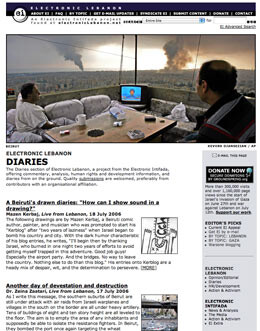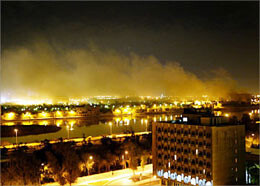The Electronic Intifada 18 July 2006
“Tell the universe what you’ve done
Out in the desert with your smoking gun
Looks like you’ve been having too much fun
Tell the universe what you’ve done”
— Bruce Cockburn, “Tell The Universe” from the album Life Short Call Now, released 18 July 2006

Index page of Electronic Lebanon’s diaries section, “Live from Lebanon”. (EI)
Our diary section, “Live from Lebanon”, has been extremely popular, offering accounts from Beirut and other cities under bombardment in Lebanon.
“At the sound of the first bomb that hit quite close to our home,” wrote Rania Masri on July 16th, “my cousin’s youngest son, in mere seconds, went from his strong boyish bravado-demeanor to that of a frightened little boy. He threw his ice cream cone away, and got strong stomach pains. At the sounds of the next bomb, he ran and hid under a table. I wondered how the children in the south and in the southern district of Beirut and in Ba’albeck and in Gaza were withstanding the constant noise and terror.”
“I hear it from my neighbours and friends,” wrote Maha Damaj from Beirut on July 16th, “from phone calls coming in from loved ones abroad. I hear it inside my own head. We all just feel so helpless. How exactly does one face indiscriminate attacks from the air, land and sea? A sense of claustrophobia overcame me when all routes out of Lebanon were being cut off, one after the other. I wasn’t even thinking of leaving, but their moves succeeded in making me feel trapped. My solution? Call a friend living abroad - how trapped can I be if I can still communicate with the outside world? As trite as that might sound, it worked. The magic of psychology.”
There has been a lot of media interest in these diaries, and many U.S. news networks are offering reports about voices from the ground and blogs to varying degrees in their reporting.
Some networks have been reporting that the phenomenon of blogging from warzones is “new”. This is not the case. Members of the Electronic Intifada team have been pioneering alternative media reporting from Middle Eastern warzones for over 10 years.
EI’s Nigel Parry headed the Birzeit University team that published the first alternative news website from within a warzone, from the Palestinian West Bank town of Ramallah during the September 1996 Clashes.
During Israel’s “Operation Defensive Shield” in March/April 2002, the Electronic Intifada team presented the only reports from residents within Ramallah when it was put under Israeli closure, even to the press. CNN’s Michael Holmes was literally the only mainstream journalist inside the town during its closure, making EI’s contribution unique.

Lights in the window of the Al-Fanar Hotel in Baghdad show the locations of members of the Iraq Peace Team — reporting for Electronic Iraq — during a nearby US bombing attack. (Al-Jazeera)
In 2003, the ADC (the “NAACP for arabs”) “Voices for Peace” award was presented to EI and eIraq “in recognition of its commitment to bringing the concerns, voices, and experiences of the Iraqi and Palestinian peoples to audiences the world over via the Internet.”
Electronic Iraq and The Electronic Intifada have received requests for archiving from both the Library of Congress and the British Library (the UK’s Library of Congress).
Today, via Electronic Lebanon, available at http://electronicLebanon.net, the team continues its work.
EI has seen more than 300,000 visits and over 1,160,000 page views since the start of Israel’s invasion of Gaza on June 27th, and Israel’s war against Lebanon on July 12th.
Since July 12th, EI has seen 127,000 visits and 511,000 page views.
On July 17th, alone, there were 29,000 visits to the site and 124,500 page views. Prior to the current crisis in the Middle East, visits to the site have tended to average at 10,000 visits daily and 40,000 page views.
Visit Electronic Lebanon at http://electronicLebanon.net to hear voices from on the ground.
ABOUT EI
The Electronic Intifada (EI) is a not-for-profit, independent publication committed to comprehensive public education on the question of Palestine, the Israeli-Palestinian conflict, and the economic, political, legal, and human dimensions of Israel’s 39-year occupation of Palestinian territories. EI provides a needed supplement to mainstream commercial media representations of the Israeli-Palestinian conflict. Visit EI at http://electronicIntifada.net
“The Palestinian CNN” - The Jerusalem Post
”[EI is]… something quite spectacular …a highly professional site.” — David Bowden, The Financial Times (U.K.)
“The Electronic Intifada is trusted” — Alexander Cockburn, The Nation (U.S.)
”[EI is] a democratic bombshell, a fascinating look between and behind the lines.” — The Web Review, ITV (UK)
“Making the pro-Palestinian cause more prominent with the media in recent years.” — Newsday (U.S.)
“Intended as a news source, the site has slowly been transforming into a work of art…” — The Daily Star (Lebanon)

